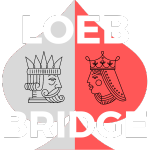On the auction below, what does South's 3♣ bid show?
- A minimum opener with long clubs like ♠73 ♥A5 ♦K94 ♣KQJT72
- A strong opening hand with long clubs like ♠A3 ♥75 ♦K94 ♣AKQT72
| South | West | North | East |
| 1♣ | 1♥ | 1♠ | 2♥ |
| 3♣ |
If North held ♠K9765 ♥K74 ♦A85 ♣94, North should pass opposite hand 1 and bid 3NT opposite hand 2. There isn't enough bidding room for natural bidding to provide separate ways to show a competitive hands and hands with extra values. Guessing which hand South has can be costly. A way to differentiate a competitive bid from a bid showing extra values is needed. Not having enough room for natural bidding to suffice is a common dilemma. It occurs when the opponents interfere in your 1NT auction, when partner makes a takeout double of a Weak 2 bid, and after opener's reverse. In all of these situations, the solution is to give up a natural bid, and use it to clarify the meaning of other bids.
The Good-Bad 2NT convention gives up a natural 2NT bid. An artificial 2NT bid is used when you want to compete at the 3-level. Bypassing the artificial 2NT bid, and bidding a suit directly at the 3-level shows extra values.
Playing Good-Bad 2NT, South would use the auction below with ♠A3 ♥75 ♦K94 ♣AKQT72 to show a competitive hand with long clubs.
| South | West | North | East |
| 1♣ | 1♥ | 1♠ | 2♥ |
| 3♣ |
Playing Good-Bad 2NT, South would use the auction below with ♠73 ♥A5 ♦K94 ♣KQJT72 to show a competitive hand with long clubs.
| South | West | North | East |
| 1♣ | 1♥ | 1♠ | 2♥ |
| 2NT* | Pass | 3♣ | Pass |
| Pass | Pass |
After South uses the artificial 2NT bid showing a desire to compete somewhere, East's 3♣ bid shows a willingness to stop at 3♣ if East has a competitive hand with long clubs. If East is too strong or too shapely to stop at 3♣, East makes a bid to describe their hand.
On the auction below, South's artificial 2NT bid shows a desire to compete somewhere. South could have a hand with long diamonds, a hand with clubs and diamonds, or may wish to compete in hearts. North must account for these possibilities. If South is to strong or too shapely to stop in 3♣ or 3♦, South should make a bid which describes their hand. If North is willing to stop in a partscore and has a preference for clubs over diamonds, South should bid 3♣. If North has no preference between the minors and has a preference for diamonds, North should bid 3♦. Either way, South has room to show a competitive hand with a heart fit if that is what they have.
| South | West | North | East |
| 1♦ | 1♠ | X | 2♠ |
| 2NT* | Pass | ? |
If you are in a forcing auction, e.g. a 2/1 auction, a 2NT bid is natural. In a competitive auction where you are not in a force, a natural 2NT bid has a very narrow target. It is best to use a 2NT bid over a 2♦, 2♥, or 2♠ bid by the opponents as artificial. If one of us has already bid and game is a possibility, Good - Bad 2NT applies. If game isn’t a possibility, 2NT typically shows 2 places to play.
Here is a more detailed description of when Good-Bad 2NT applies when:
- we have not bid and raised a major
- we have not opened or overcalled 1NT (lebensohl applies)
- a pass would not be forcing
- when your partner has taken a bid
- the opponents bid 2♦, 2♥, or 2♠ over partner's last bid
- when game is a possibility (e.g. wouldn't apply for 2 passed hands)
The following auction should be an exception to Good-Bad 2NT. It is essential for East to be able to show a heart fit immediately. Using an artificial 2NT bid to show a competitive hand risks South bidding 3♠, depriving East of their chance to show a competitive heart raise. East cannot use a 3♠ cue bid to show an invitational heart raise. East-West wouldn't be able to stop in 3♥.
| South | West | North | East |
| 1♠ | 2♥ | 2♠ | ? |
East needs to be able to show a competitive heart raise immediately and needs to be able show an invitational or better heart raise immediately. On this auction, we recommend bidding 3♥ with a competitive heart raise. Use an artificial 2NT bid to show an inv
we use 2NT to show an invitational or better heart raise.




